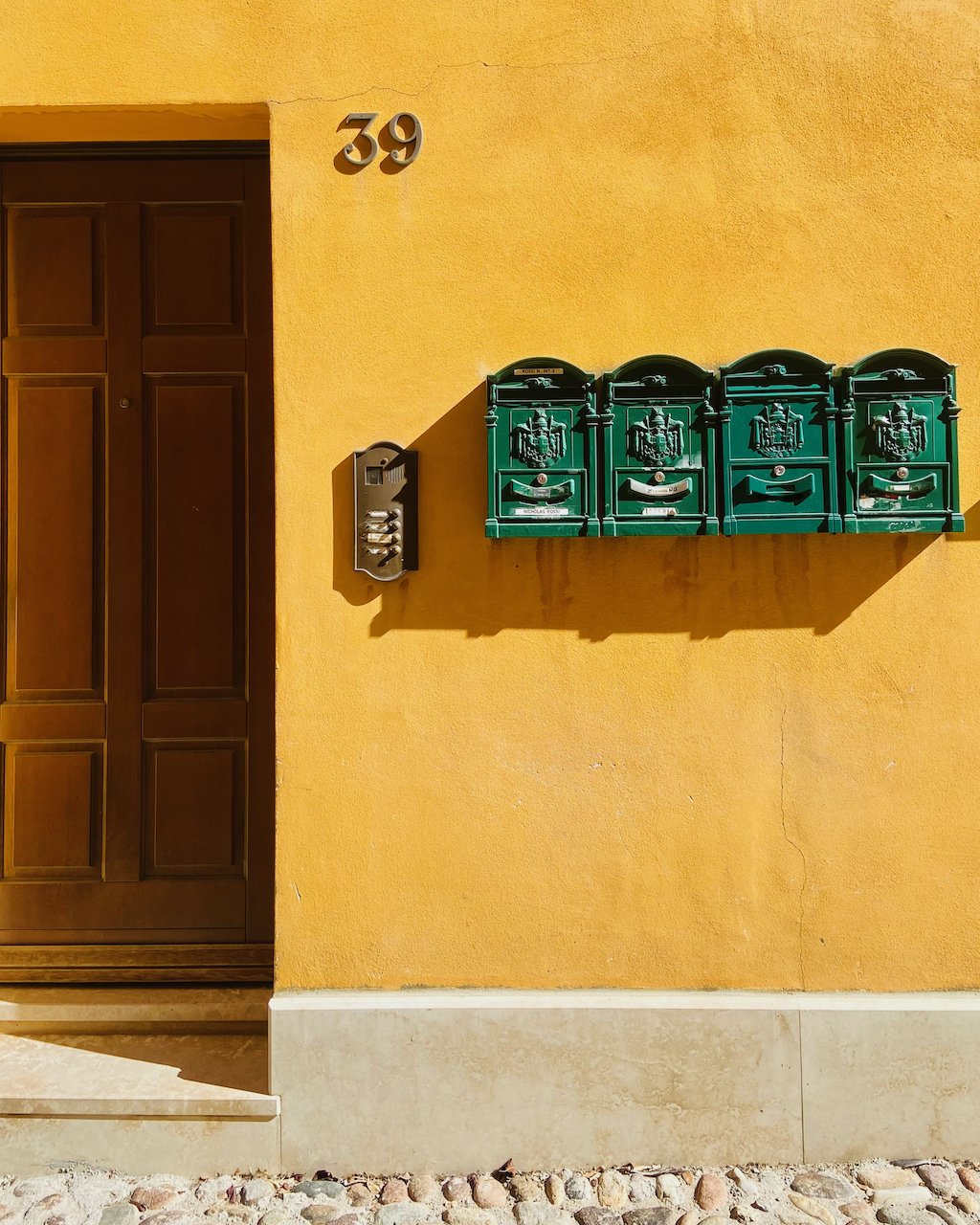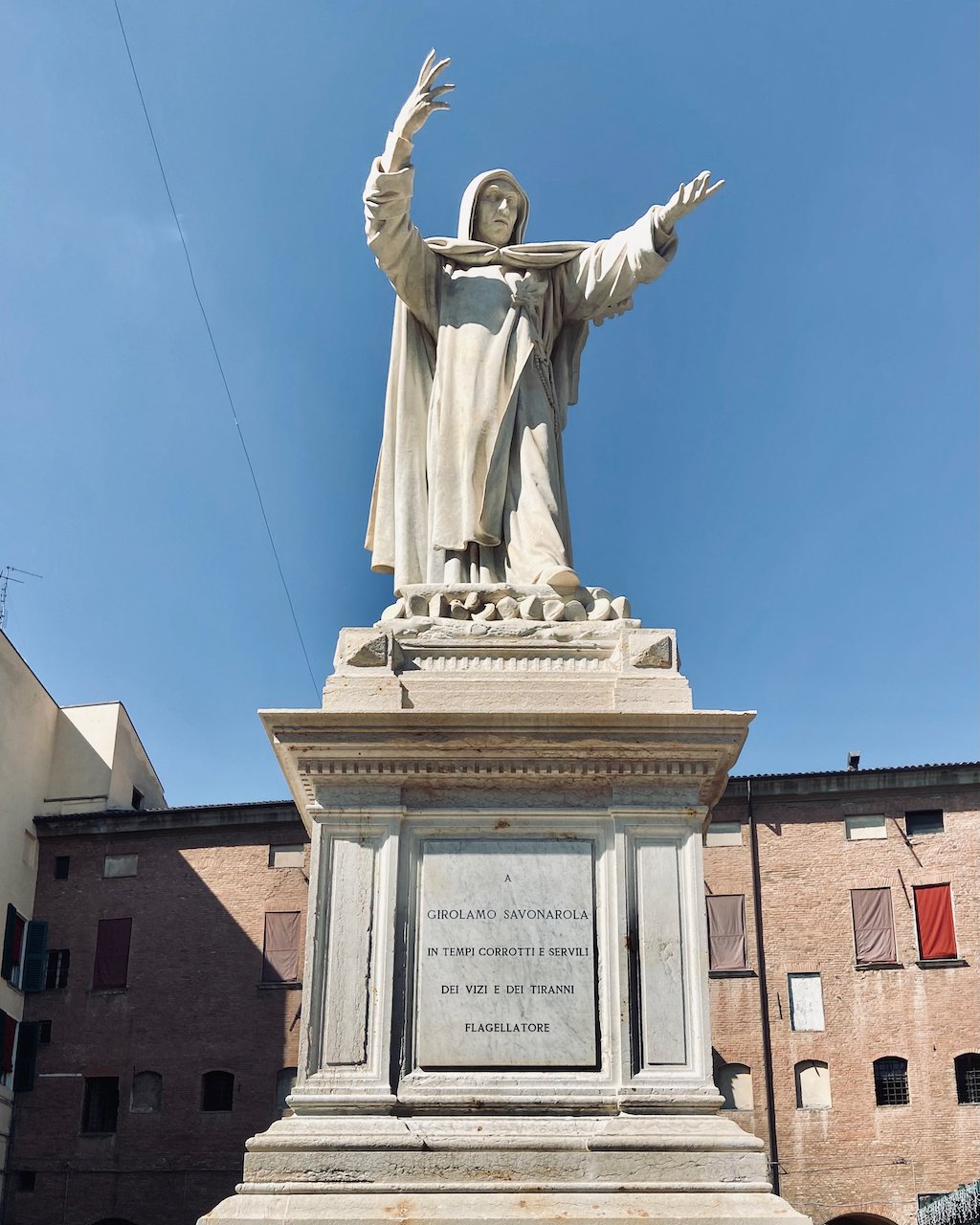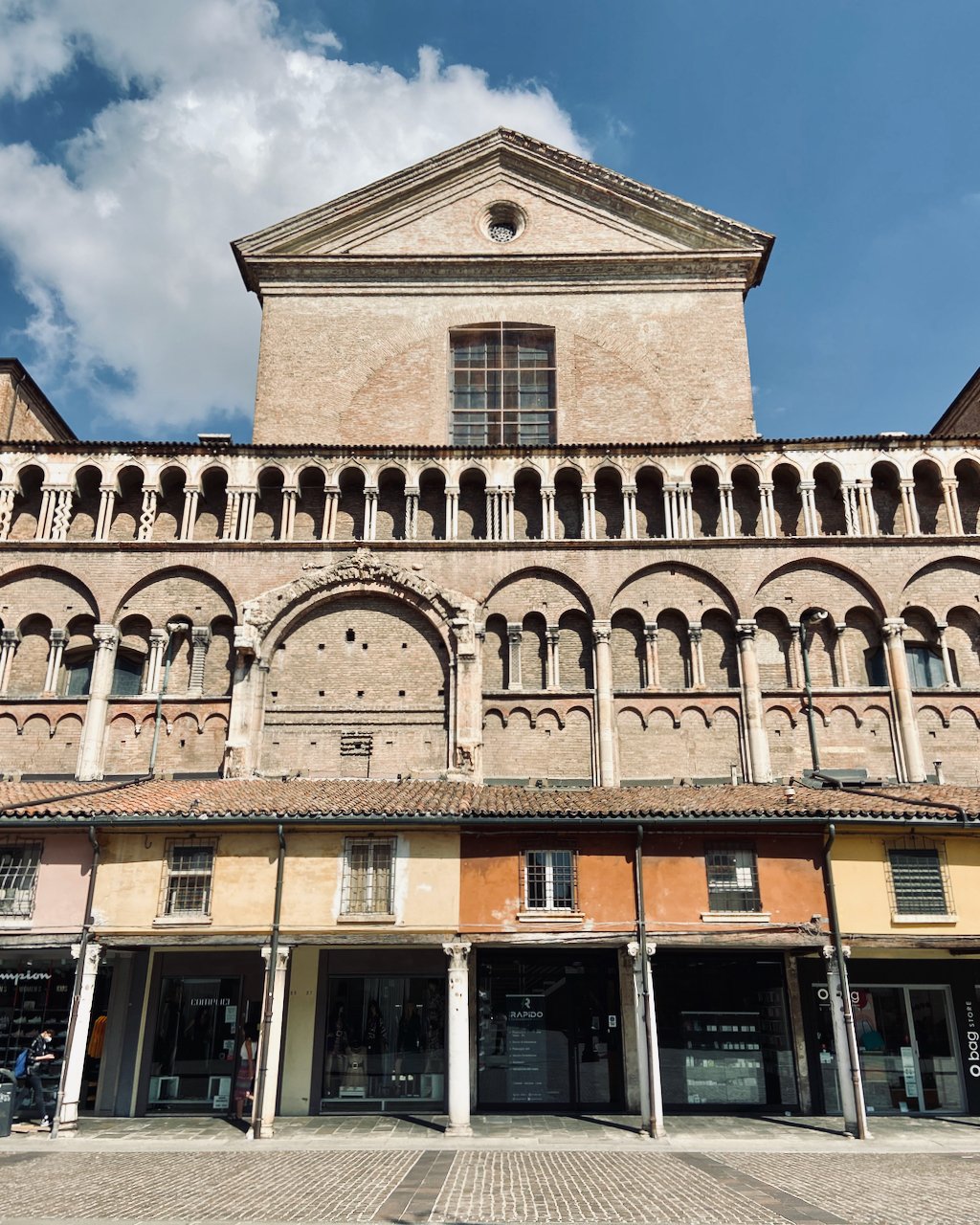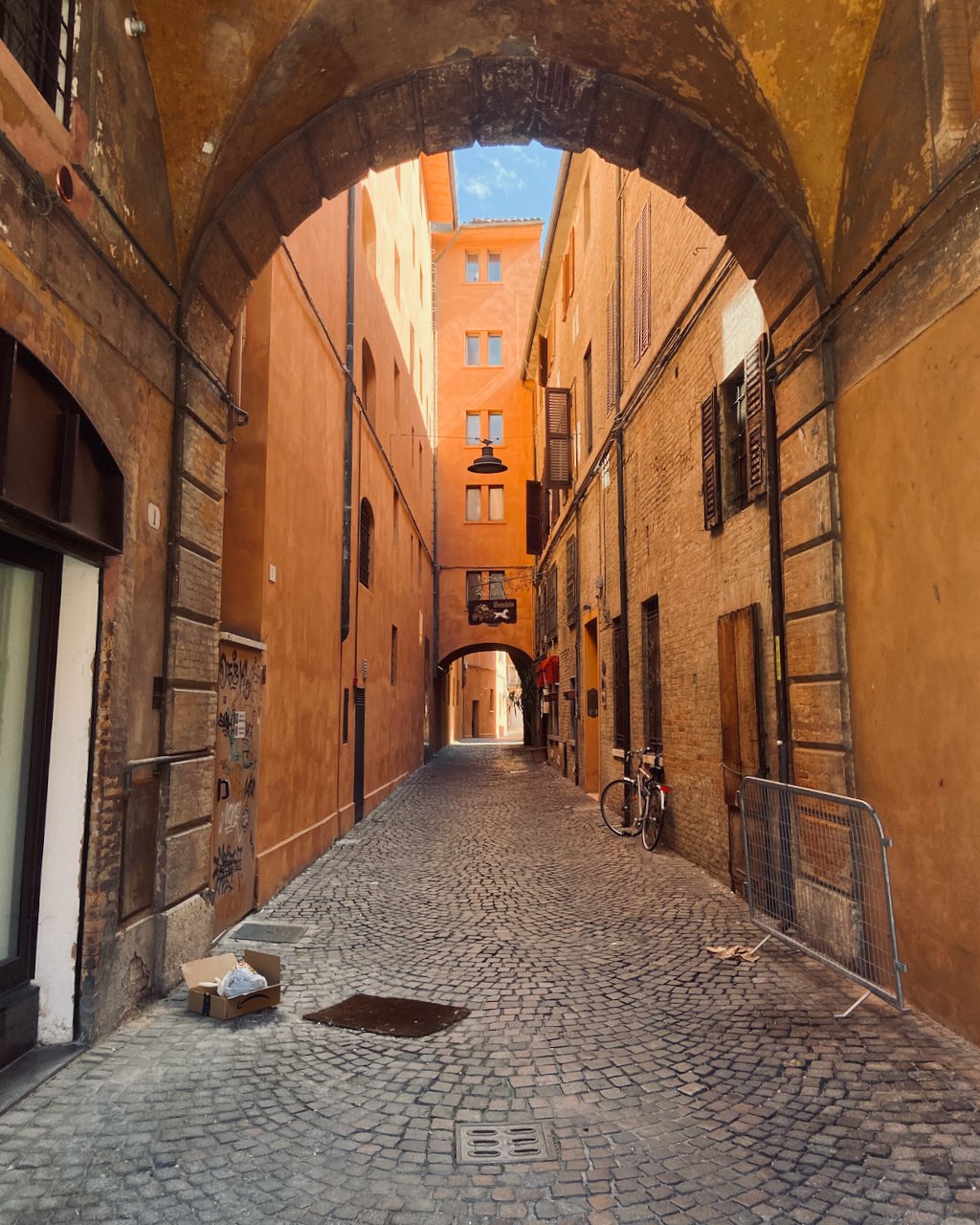Discovering the Walls of Ferrara and Medieval Mestiere
One of Ferrara’s colourful buildings (Photo: Reuben Brown)
There is a woman walking out of the doorway holding a grey plastic tray laden with two red espresso cups and saucers. I see her between my elbows leant on a stone windowsill. By the time I come downstairs and out to the canal-side for my own breakfast one of the cups is empty and stained by the woman’s lipstick; her companion is spooning undissolved sugar from the bottom of the other.
I’m in Venice for a workshop with the Architecture Biennale, and I have, for a few days, been itching to leave — there’s something comfortable about it, internationalised. And because I’m comfortable I can’t relax. The exhibitions aren’t open on Tuesdays and I have a day to make a film — but I can edit on the train. So I book a ticket on my phone as the garbage boat sidles up to the street and extends its little crane to lift the hostel’s trash into its hull.
Ferrara’s only an hour away. Grace’s parents live there and I send her an email from the train, asking for something to see and a place to eat. Before her reply, though, I am aimless. Walking south-east down Viale Cavour towards the Este family’s castle, past a man playing trumpet at a junction and someone lying in a circular arch cut through a brick wall. By the end of the day I will know where I am, I will know the streets that connect to this street, but not yet — it’s around midday, the air syrupy hot and thick.
The statue of Girolamo Savanarola, Ferrara (Photo: Reuben Brown)
The moat around the castle is stocked with orange and black carp, shadowy behind the variegated green scum on the water’s surface. I cross it on a wooden drawbridge and enter the courtyard, heavy with uncountable red bricks, bearing the marks of successive renovations. Then continue on past a monument to 15th-century preacher Girolamo Savonarola in corrupt and servile times of vices and scourging tyrants, which could have been a model for Emperor Palpatine — arms thrown outwards from a hooded cape, as if spitting lightning.
I find a spot in the shade on Corso Martiri della Libertà and listen to the street for a few minutes: low voices and high voices passing in slow rhythm, bike chains rattling on the cobblestones, the distant whine of a Vespa. There’s something sweetly beautiful about it all, something communal. So I pass on, acquainted with the atmosphere now, into a family restaurant for a stodgy plate of deep-fried artichokes and a beer. Then North, through the oval courtyard of the Teatro Comunale (I suspect the Enlightenment discovery of elliptical planetary orbits is at play, the marble eye at the centre of the pavement the scientific observer’s), and the Palazzo dei Diamanti — another Este building, studded by thousands of pointed marble blocks, angled in various ways to catch the light as if shimmering.
Ferrara’s shop frontages (Photo: Reuben Brown)
But Ferrara has its humble moments too; it is a city to wander in, to be lost in. At every turn something takes the eye: window arches rich with fine ornamentation; the play of light on a bike rack through diaphanous scaffolding cloth; the contrapuntal rhythms of ever-finer columns in the Piazza; perfect shadows from little green post boxes on a yellow-plastered wall; or the places where that plaster is cut through to reveal the structure of brick archways. Everywhere is the dedicated appreciation of mestiere — craft.
In the south-west of the city I pass an apartment building with fifteen exterior cables rising up its side. Rather than relegate this infrastructure to an unfortunate necessity, it is celebrated as an ornament, elevated to a craft: architraves part ways for this run of wires, each splitting to its destination in perfect legible harmony. It is as much a marvel as the aqueduct I spend the afternoon besides, reading. Once more, this is a heavy, necessary infrastructure, not hidden and relegated, but risen and celebrated as a public good. Beneath its dodecagonal colonnade is a family centre and children’s library. At 3pm the little park around its base fills with laughter and play.
I return to the piazza in the early evening for another beer, loosely drawing the geometries of a scaffold at the Western end. Grace replies to my email — she’s been teaching all day and just saw it, planning lessons on ADDING!!! She says: For me Ferrara is being more than doing? Walk up Corso Ercole d’Este to the city walls — go to the charterhouse cemetery? And eat at the Osteria del Cammello. I write back that I will walk to the cemetery and return for dinner, and she doubles down: The walls though!!! Focus on the walls. Take the path that smells sweet like figs.
A cobbled passageway in Ferrara (Photo: Reuben Brown)
So I do, and find the ramparts deep and thick and red and brown. Joggers and cyclists and dog walkers stream along the gravel path, but I go down to the bricks themselves and think about Grace — separated not by location but by time — and everyone else I care for. Build the city with love and the city will give love back.
So come back to the city, sky growing dark, and apologise in broken Italian for being a little early to the Osteria — my train is soon, for now just a drink? The young waiter pours a white wine that I only have the language to describe as perfetto and I read some more. When he returns to take my order, I ask to let the chef decide — two courses, wine with each. I am brought a morsel of soup thick and creamy, then seafood simply cooked and perfectly seasoned with fresh vegetables, before the same fish are served in a thicker, deeper dish somewhere between risotto and paella. A half-scoop of ice cream arrives before I leave, and a shot of limoncello. Everything that touches my tongue is delivered with love, with craft, with mestiere.
Stomach full, I have to run to the station, swing onto my train and reluctantly return to Venice. These medieval cities, enclosed in their walls, you can learn them in a day. In their love each is the same, but in their self-sufficiency each is unique. Take me to Modena tomorrow, and Ravenna the day after; Forlì might be next, and Siena after that. These familiar unfamiliarities will wait for another time.



